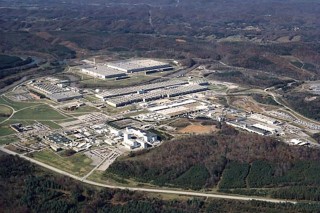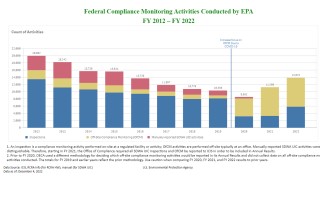Enforcement and Compliance Annual Results for Fiscal Year 2022
During fiscal year (FY) 2022, EPA’s enforcement and compliance program continued its mission to target the most serious water, air, land, and chemical violations and hazards that impact communities across the country. Our work reduced, treated or eliminated 95 million pounds of pollutants, and required violators to pay over $300 million in penalties fines and restitution. Our primary focus was advancing environmental justice (EJ), rebuilding EPA’s national inspector corps, and working to mitigate the effects of climate change, particularly in communities overburdened by pollution.
The Office of Enforcement and Compliance Assurance (OECA) committed in EPA’s Strategic Plan to increase the percentage of annual on-site inspections in communities with potential EJ concerns from 30% to 55% by FY 2026. In FY 2022, EPA outperformed and achieved 56% of on-site inspections in overburdened communities. Noted in the sections below, our FY 2022 accomplishments focused on protecting vulnerable communities using the full range of compliance monitoring and enforcement tools, including inspections, technical assistance supported by advanced technologies, and early actions and innovative remedies to ensure high levels of compliance with federal environmental laws and regulations.
Working for Your Community
The Office of Enforcement and Compliance Assurance (OECA) focuses on identifying and addressing noncompliance and contaminated sites that adversely impacts American communities through vigorous civil, criminal, and cleanup enforcement.
Environmental Justice
Former President Biden has called upon EPA to strengthen enforcement of environmental violations with disproportionate impact on overburdened communities. (EO 14008).
Drinking Water
Providing safe drinking water is a partnership that involves EPA, the states, tribes, public water systems and their operators, and certified laboratories that conduct analyses of drinking water samples collected by public water systems.
Lead
Exposure to lead in environmental media — soil, water, air, and in paint — can cause serious health problems.
National Enforcement and Compliance Initiatives
EPA focuses its enforcement and compliance resources on the most serious environmental violations by developing and implementing national program priorities called National Enforcement and Compliance Initiatives.
Fulfilling Our Mission
Ensure compliance with environmental laws and regulations to address violations that pose the greatest threat to human health and the environment in a fair and equitable manner to ensure a level playing field for all regulated businesses.
FY 2022 Enforcement and Compliance accomplishments include the following highlights:
- Over 56% of on-site inspections were at facilities affecting communities with potential EJ concerns, exceeding the 45% goal set for this year.
- EPA’s enforcement staff concluded approximately 1,650 civil judicial and administrative cases; of these cases, over 44% addresses facilities in areas with potential EJ concerns, the highest percentage since FY 2014, when we began tracking. For example:
- USS Lead (East Chicago, IN): In this historically overburdened community, EPA secured commitments from multiple parties and a purchaser to clean up a large former industrial area contaminated with lead and arsenic and return it to a productive use.
- EPA’s criminal program concluded important cases to protect health and the environment. For example:
- EPA with its federal partners demonstrated that major corporations like FCA US LLC (FCA US),formerly Chrysler Group LLC, will be held accountable for complying with vehicle emission standards. FCA US was sentenced to pay approximately $300 million in criminal penalties.
- OECA stood up a new AIM Act enforcement program to prohibit illegal imports of hydrofluorocarbons (HFCs) in partnership with U.S. Customs and Border Protection; denial of entry to HFC imports in 2022 prevented 889,000 metric tons of CO2 equivalents from entering the U.S.
- EPA took aggressive early actions in overburdened communities to address drinking water violations, issuing 86 drinking water orders to protect eight million people using public water systems. Fifteen of the orders were to address emergency conditions in overburdened communities.
- Achieved the goal of a 50% reduction of significant noncompliance among facilities permitted under the Clean Water Act. The national significant noncompliance (SNC) rate has been reduced from 20.3% at the start of 2018 to 9.0% in FY 2022.
- EPA worked with federal agencies to reduce the SNC rate at federal facilities by 64% compared to the FY18 baseline.
- OECA released ECHO Notify, an email service that allows communities to get email alerts when a local facility has a violation or enforcement action.








